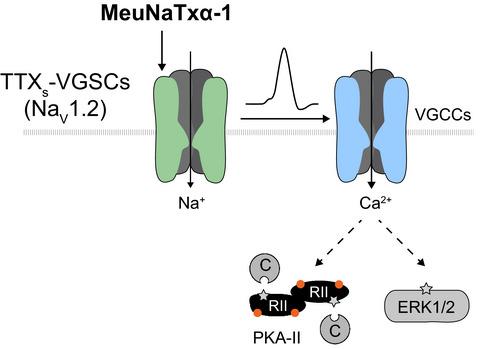Our official English website, www.x-mol.net, welcomes your feedback! (Note: you will need to create a separate account there.)
Scorpion toxin MeuNaTxα‐1 sensitizes primary nociceptors by selective modulation of voltage‐gated sodium channels
The FEBS Journal ( IF 5.4 ) Pub Date : 2020-10-13 , DOI: 10.1111/febs.15593 Marianne van Cann 1 , Alexey Kuzmenkov 2 , Jörg Isensee 1 , Alexander Andreev-Andrievskiy 3 , Steve Peigneur 4 , Georgii Khusainov 2, 5 , Antonina Berkut 2 , Jan Tytgat 4 , Alexander Vassilevski 2, 5 , Tim Hucho 1
The FEBS Journal ( IF 5.4 ) Pub Date : 2020-10-13 , DOI: 10.1111/febs.15593 Marianne van Cann 1 , Alexey Kuzmenkov 2 , Jörg Isensee 1 , Alexander Andreev-Andrievskiy 3 , Steve Peigneur 4 , Georgii Khusainov 2, 5 , Antonina Berkut 2 , Jan Tytgat 4 , Alexander Vassilevski 2, 5 , Tim Hucho 1
Affiliation

|
Venoms are a rich source of highly specific toxins, which allow the identification of novel therapeutic targets. We have now applied high content screening (HCS) microscopy to identify toxins that modulate pain sensitization signaling in primary sensory neurons of rat and elucidated the underlying mechanism. A set of venoms and fractions thereof were analyzed for their ability to activate type II protein kinase A (PKA‐II) and extracellular signal‐regulated kinases (ERK1/2). We identified MeuNaTxα‐1, a sodium channel‐selective scorpion α‐toxin from Mesobuthus eupeus, which affected both PKA‐II and ERK1/2. Recombinant MeuNaTxα‐1 showed identical activity to the native toxin on mammalian voltage‐gated sodium channels expressed in Xenopus laevis oocytes and induced thermal hyperalgesia in adult mice. The effect of MeuNaTxα‐1 on sensory neurons was dose‐dependent and tetrodotoxin‐sensitive. Application of inhibitors and toxin mutants with altered sodium channel selectivity demonstrated that signaling activation in sensory neurons depends on NaV1.2 isoform. Accordingly, the toxin was more potent in neurons from newborn rats, where NaV1.2 is expressed at a higher level. Our results demonstrate that HCS microscopy‐based monitoring of intracellular signaling is a novel and powerful tool to identify and characterize venoms and their toxins affecting sensory neurons.
中文翻译:

蝎毒素MeuNaTxα-1通过选择性调节电压门控钠通道来敏化原发伤害感受器
毒液是高度特异性毒素的丰富来源,可用于鉴定新的治疗靶标。现在,我们已经应用高含量筛选(HCS)显微镜来鉴定可调节大鼠主要感觉神经元中疼痛敏化信号的毒素,并阐明了其潜在机制。分析了一组毒液及其组分激活II型蛋白激酶A(PKA-II)和细胞外信号调节激酶(ERK1 / 2)的能力。我们鉴定了MeuNaTxα-1,一种来自Mesobuthus eupeus的钠通道选择性蝎子α-毒素,它影响了PKA-II和ERK1 / 2。重组MeuNaTxα-1在非洲爪蟾中表达的哺乳动物电压门控钠通道上具有与天然毒素相同的活性卵母细胞和成年小鼠诱发的热痛觉过敏。MeuNaTxα-1对感觉神经元的作用是剂量依赖性和河豚毒素敏感的。钠通道选择性改变的抑制剂和毒素突变体的应用表明,感觉神经元中的信号激活取决于Na V 1.2同工型。因此,毒素在新生大鼠的神经元中更有效,其中Na V 1.2的表达水平更高。我们的结果表明,基于HCS显微镜的细胞内信号传导监测是一种新颖而强大的工具,可用于识别和表征影响感觉神经元的毒液及其毒素。
更新日期:2020-10-13
中文翻译:

蝎毒素MeuNaTxα-1通过选择性调节电压门控钠通道来敏化原发伤害感受器
毒液是高度特异性毒素的丰富来源,可用于鉴定新的治疗靶标。现在,我们已经应用高含量筛选(HCS)显微镜来鉴定可调节大鼠主要感觉神经元中疼痛敏化信号的毒素,并阐明了其潜在机制。分析了一组毒液及其组分激活II型蛋白激酶A(PKA-II)和细胞外信号调节激酶(ERK1 / 2)的能力。我们鉴定了MeuNaTxα-1,一种来自Mesobuthus eupeus的钠通道选择性蝎子α-毒素,它影响了PKA-II和ERK1 / 2。重组MeuNaTxα-1在非洲爪蟾中表达的哺乳动物电压门控钠通道上具有与天然毒素相同的活性卵母细胞和成年小鼠诱发的热痛觉过敏。MeuNaTxα-1对感觉神经元的作用是剂量依赖性和河豚毒素敏感的。钠通道选择性改变的抑制剂和毒素突变体的应用表明,感觉神经元中的信号激活取决于Na V 1.2同工型。因此,毒素在新生大鼠的神经元中更有效,其中Na V 1.2的表达水平更高。我们的结果表明,基于HCS显微镜的细胞内信号传导监测是一种新颖而强大的工具,可用于识别和表征影响感觉神经元的毒液及其毒素。



























 京公网安备 11010802027423号
京公网安备 11010802027423号